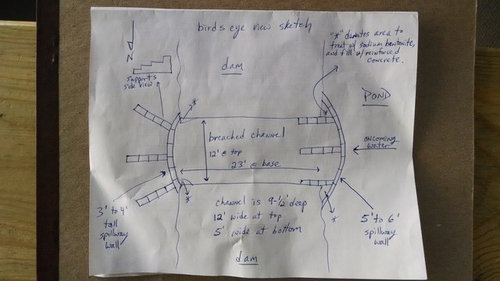I have a pond that breached the dam before I owned the property. Apparently, the last dam lasted for quite a while, about 20 to 30 years. It was simply compacted dirt with a culvert stuck through it at about the 4� high. It appears water started leaking around the entryway to the culvert and eventually washed out the dam over a couple of years.
I need to repair the dam so I can collect water in the pond, attract waterfowl, and use it elsewhere by pumping it for irrigation or to fill other small isolated ponds.
The dimensions of the breached area are:
23 feet long channel
12 feet wide at top of channel
5 feet wide at bottom of channel
9-1/2 feet deep
If I put a spillway wall in it would be about 20 feet wide at the front, curved towards the oncoming water pressure. It would be a single wall of CMU w/reinforced concrete poured from top to bottom in the voids. It would also have 3 support ribs of CMU wall supporting it w/reinforced concrete poured from the top down as well.
The rear spillway would be about 10 feet wide, curved away from oncoming water, supported behind it with 3 rows of CMU, w/reinforced concrete poured from the top-down as well.
Please see the rough sketch for my idea. Do you think it would work and last in normal conditions?









waterbug_guy
ylekyoteOriginal Author
Related Professionals
Surprise Landscape Architects & Landscape Designers · Arnold Landscape Architects & Landscape Designers · Saint Charles Landscape Architects & Landscape Designers · Salisbury Landscape Architects & Landscape Designers · Elgin Landscape Contractors · Springfield Landscape Contractors · Blue Springs Landscape Contractors · Bowie Landscape Contractors · Fairfield Landscape Contractors · Fuquay-Varina Landscape Contractors · Milford Mill Landscape Contractors · North Richland Hills Landscape Contractors · Red Oak Landscape Contractors · San Carlos Park Landscape Contractors · Wickliffe Landscape Contractorswaterbug_guy
ylekyoteOriginal Author
waterbug_guy